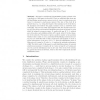Free Online Productivity Tools
i2Speak
i2Symbol
i2OCR
iTex2Img
iWeb2Print
iWeb2Shot
i2Type
iPdf2Split
iPdf2Merge
i2Bopomofo
i2Arabic
i2Style
i2Image
i2PDF
iLatex2Rtf
Sci2ools
SSS
2005
Springer
2005
Springer
Synchronous vs. Asynchronous Unison
This paper considers the self-stabilizing unison problem. The contribution of this paper is threefold. First, we establish that when any self-stabilizing asynchronous unison protocol runs in synchronous systems, it converges to synchronous unison if the size of the clock K is greater than CG, CG being the length of the maximal cycle of the shortest maximal cycle basis if the graph contains cycles, 2 otherwise (tree networks). The second result demonstrates that the asynchronous unison in [3] provides a universal self-stabilizing synchronous unison for trees which is optimal in memory space. It works with any K ≥ 3, without any extra state, and stabilizes within 2D rounds, where D is the diameter of the network. This protocol gives a positive answer to the question whether there exists or not a universal self-stabilizing synchronous unison for tree networks with a state requirement independant of local or global information of the tree. If K = 3, then the stabilization time of this pr...
| Added | 28 Jun 2010 |
| Updated | 28 Jun 2010 |
| Type | Conference |
| Year | 2005 |
| Where | SSS |
| Authors | Christian Boulinier, Franck Petit, Vincent Villain |
Comments (0)

